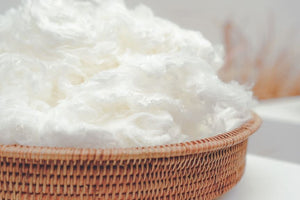
Bamboo viscose production
Bamboo is what is known in textile terminology as a chemofiber, specifically a subcategory of regenerated fibers. A regenerated fiber is produced using natural chemical compounds extracted from bamboo, wood, cotton waste, and similar plants and plant parts with high cellulose content. They often have a beautiful sheen, are wrinkle-resistant, and easier to clean.
It began with the development of viscose in the late 19th century, and most recently, the Lyocell manufacturing method was introduced in the early 1990s, aiming for a process that is less environmentally burdensome.
In broad terms, the plant material is first cut into smaller pieces (wood chips). Then it is dissolved into a pulp, and the cellulose is extracted. The syrup-like substance produced is called "schmelze." Next, it is passed through a spinneret, a funnel with small holes.
The strands that come out are drawn to the desired thinness, after which the fibers are cooled, washed, dried, and finally wound onto spools as continuous filament yarn.

Lyocell production
The Lyocell method is very similar to the process described above, with one crucial difference: the Lyocell method operates in a closed-loop system where the chemicals used in the breakdown process are recycled.
These chemicals in the breakdown process have yet to find an environmentally friendly alternative, hence a system has been created to reuse about 99% of them. Additionally, this method requires significantly less water compared to traditional viscose production.
It's worth noting that Lyocell is also known as Tencel, but the name Tencel can only be used when the material comes from the Austrian factory Lenzing, which is at the forefront of environmentally friendly production methods.
The majority of the clothing we sell here at Copenhagen Bamboo is FSC®- and OEKO-TEX certified. You can read more about FSC® certification here and OEKO-TEX certification here.
